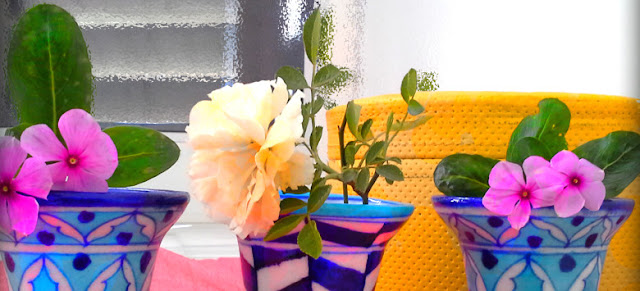As promised, am back with a feature on an enterprise that specializes in Blue Pottery from Jaipur.The last two posts on Pottery was like a prelude to this wonderful organisation that deals in an art which is the oldest yet so mesmerizing!
Aurea Blue Pottery is a socially motivated enterprise established with the aim of reviving the traditional art of Jaipur's Blue Pottery and providing livelihood to craftsmen. Their elegantly styled product range comprises of unique souvenirs including home decor accessories, office and desk accessories and premium gifts.
Aurea as the name suggests is unique...Very Individualistic and splendid in its creation.Fine craftsmanship and the striking design really left me spell bound.
If you have not read my earlier post on Blue Pottery, read it here. Aurea Blue Pottery takes pride in the fact that every piece is hand painted and is clearly a labor of love.The distinct blue colour makes every piece stand out. After the extensive process of giving a final form and shape to each piece, the designs are painted with precision and mind you, it is free hand! The transparent glaze and firing in the furnace finishes the product.
Let me 'show off' two of the planters, that adorns my green space .Will truly cherish these beauties knowing that these were laboriously hand crafted by skilled artisans.
For all the green thumbs and garden enthusiasts out there,these planters are a must have.Would love to have a collection of the lovely planters in different designs and yes, a limited range of planters in olive green & black colour is also available.

Ms Roopal , the founder and designer behind Aurea lays emphasis on customer satisfaction which was rightfully established when my products were delivered safe and on time.
The challenge with such unique craft forms and organisations engaged in this art is that, they have to keep up with the modern times and sustain their handmade products amidst mass produced items.
Aurea Blue Pottery makes sure that the designs are suitable for modern homes and meets all required standards.Marketing efforts are also channelized such that the enchanting pieces meet the discerning eye.
Next time you are in Jaipur, do not forget to visit their outlet at:
Aurea Blue Pottery
Office: K-10, Laxman Path, Shyam Nagar, Jaipur (Rajasthan, INDIA)
Retail Store: Hotel Rangoli, M.I. Road, Jaipur (Rajasthan, INDIA)
Contact: +91 98295 70227
You can also order Aurea Blue Pottery through their Facebook page or their website.


















